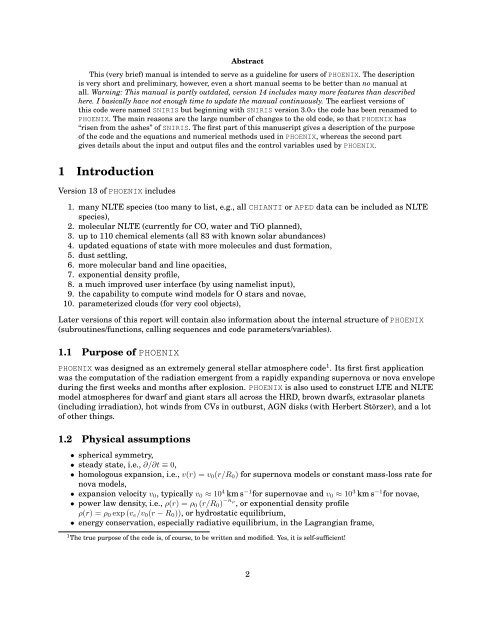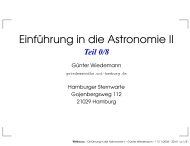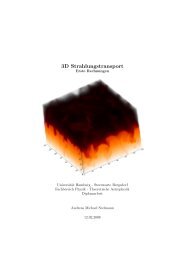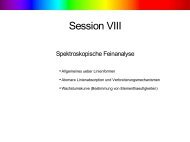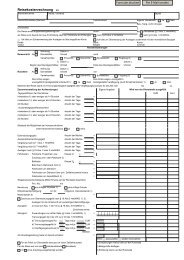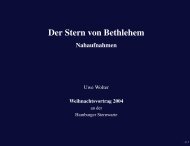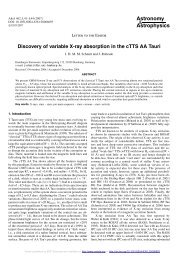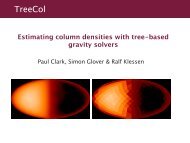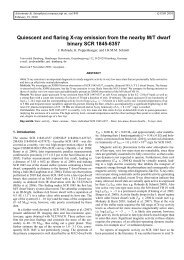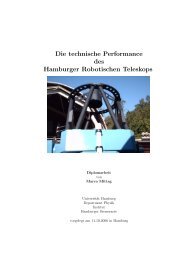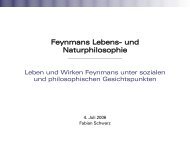Version 15 June 2007 compiled: 11-11-2009 - Hamburger Sternwarte
Version 15 June 2007 compiled: 11-11-2009 - Hamburger Sternwarte
Version 15 June 2007 compiled: 11-11-2009 - Hamburger Sternwarte
Create successful ePaper yourself
Turn your PDF publications into a flip-book with our unique Google optimized e-Paper software.
Abstract<br />
This (very brief) manual is intended to serve as a guideline for users of PHOENIX. The description<br />
is very short and preliminary, however, even a short manual seems to be better than no manual at<br />
all. Warning: This manual is partly outdated, version 14 includes many more features than described<br />
here. I basically have not enough time to update the manual continuously. The earliest versions of<br />
this code were named SNIRIS but beginning with SNIRIS version 3.0α the code has been renamed to<br />
PHOENIX. The main reasons are the large number of changes to the old code, so that PHOENIX has<br />
“risen from the ashes” of SNIRIS. The first part of this manuscript gives a description of the purpose<br />
of the code and the equations and numerical methods used in PHOENIX, whereas the second part<br />
gives details about the input and output files and the control variables used by PHOENIX.<br />
1 Introduction<br />
<strong>Version</strong> 13 of PHOENIX includes<br />
1. many NLTE species (too many to list, e.g., all CHIANTI or APED data can be included as NLTE<br />
species),<br />
2. molecular NLTE (currently for CO, water and TiO planned),<br />
3. up to <strong>11</strong>0 chemical elements (all 83 with known solar abundances)<br />
4. updated equations of state with more molecules and dust formation,<br />
5. dust settling,<br />
6. more molecular band and line opacities,<br />
7. exponential density profile,<br />
8. a much improved user interface (by using namelist input),<br />
9. the capability to compute wind models for O stars and novae,<br />
10. parameterized clouds (for very cool objects),<br />
Later versions of this report will contain also information about the internal structure of PHOENIX<br />
(subroutines/functions, calling sequences and code parameters/variables).<br />
1.1 Purpose of PHOENIX<br />
PHOENIX was designed as an extremely general stellar atmosphere code 1 . Its first first application<br />
was the computation of the radiation emergent from a rapidly expanding supernova or nova envelope<br />
during the first weeks and months after explosion. PHOENIX is also used to construct LTE and NLTE<br />
model atmospheres for dwarf and giant stars all across the HRD, brown dwarfs, extrasolar planets<br />
(including irradiation), hot winds from CVs in outburst, AGN disks (with Herbert Störzer), and a lot<br />
of other things.<br />
1.2 Physical assumptions<br />
• spherical symmetry,<br />
• steady state, i.e., ∂/∂t ≡ 0,<br />
• homologous expansion, i.e., v(r) = v0(r/R0) for supernova models or constant mass-loss rate for<br />
nova models,<br />
• expansion velocity v0, typically v0 ≈ 10 4 km s −1 for supernovae and v0 ≈ 10 3 km s −1 for novae,<br />
• power law density, i.e., ρ(r) = ρ0 (r/R0) −nρ , or exponential density profile<br />
ρ(r) = ρ0 exp (ve/v0(r − R0)), or hydrostatic equilibrium,<br />
• energy conservation, especially radiative equilibrium, in the Lagrangian frame,<br />
1 The true purpose of the code is, of course, to be written and modified. Yes, it is self-sufficient!<br />
2


